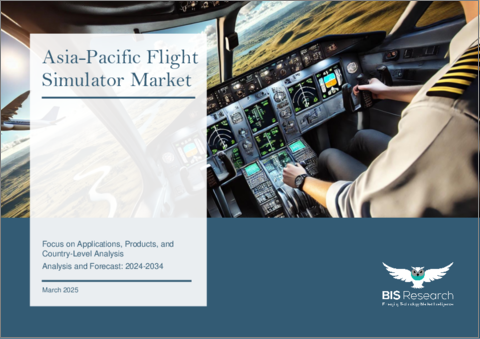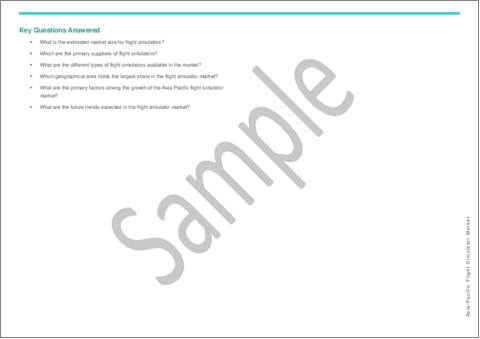|
|
市場調査レポート
商品コード
1676617
アジア太平洋のフライトシミュレータ市場:用途別、製品別、国別 - 分析と予測(2024年~2034年)Asia-Pacific Flight Simulator Market: Focus on Applications, Products, and Country-Level Analysis - Analysis and Forecast, 2024-2034 |
||||||
カスタマイズ可能
|
|||||||
| アジア太平洋のフライトシミュレータ市場:用途別、製品別、国別 - 分析と予測(2024年~2034年) |
|
出版日: 2025年03月12日
発行: BIS Research
ページ情報: 英文 64 Pages
納期: 1~5営業日
|
全表示
- 概要
- 図表
- 目次
アジア太平洋のフライトシミュレータの市場規模は、2024年の20億9,970万米ドルから2034年には43億6,660万米ドルに達し、予測期間の2024年~2034年のCAGRは7.60%になると予測されています。
バーチャルリアリティシミュレータ、飛行訓練ツール、フルフライトシステムおよび固定ベースシステムは、アジア太平洋のフライトシミュレータ市場で入手可能な数多くの製品のほんの一部に過ぎません。厳しい地域航空基準を満たす没入型パイロット訓練に対する需要の高まりにより、市場は拡大しています。AIやARを活用した最先端の開発は、シミュレーションのリアリズムを向上させ、安全上の問題を解決し、合理的なコストで訓練を提供しています。競合情勢には、新進気鋭のアジア太平洋企業と並んで、CAE Inc.、FlightSafety International、L3Harris Technologiesといった老舗の大手企業も含まれています。この地域における航空技術のダイナミックな開発は、高忠実度のシミュレーションシステムへの投資によって促進されており、民間部門と軍事部門の両方でパイロットの準備を成功させる訓練ソリューションを保証しています。
| 主要市場統計 | |
|---|---|
| 予測期間 | 2024年~2034年 |
| 2024年の評価 | 20億9,970万米ドル |
| 2034年の予測 | 43億6,660万米ドル |
| CAGR | 7.6% |
アジア太平洋のフライトシミュレータ市場は、同地域の航空産業が急速に拡大するにつれて劇的に変化しています。航空需要の増加に加え、民間部門や防衛部門におけるパイロット訓練プログラムの増加により、最先端のシミュレーション技術への投資が活発化しています。
パイロットの熟練度を向上させ、運航の安全性を保証するため、アジア太平洋の航空会社や防衛機関は、フルフライトシミュレーター、固定ベースシミュレーター、飛行訓練ツール、最先端のバーチャルリアリティ(VR)システムなど、さまざまなシミュレーションソリューションを導入しています。
規制の強化、安全性への懸念の高まり、世界のパイロット不足に直面して訓練費用を最小限に抑える必要性が、市場を後押しする主な要因となっています。シミュレーション・プラットフォームに拡張現実(AR)や人工知能(AI)を組み込むなどの技術開発により、訓練のリアリズムと効率はさらに向上しています。また、中国、インド、東南アジアなどの発展途上国では、航空インフラを近代化し、技能開発を奨励する政府プログラムも開発を後押ししています。
アジア太平洋に特化した革新的なトレーニングソリューションは、CAE Inc.、L3Harris Technologies、FlightSafety Internationalなどの業界リーダーによって積極的に投資されています。アジア太平洋のフライトシミュレータ市場は、デジタルトランスフォーメーションと安全対策の改善に重点を置き、同地域の航空セクター全体を大きく発展させることで、安定した成長が見込まれています。
当レポートでは、アジア太平洋のフライトシミュレータ市場について調査し、市場の概要とともに、用途別、製品別、国別の動向、および市場に参入する企業のプロファイルなどを提供しています。
目次
エグゼクティブサマリー
第1章 市場
- 動向:現在および将来の影響評価
- サプライチェーンの概要
- 研究開発レビュー
- 規制状況
- 市場力学の概要
第2章 地域
- 地域別概要
- アジア太平洋
第3章 市場-競合ベンチマーキングと企業プロファイル
- 今後の見通し
- 地理的評価
- CnTech Co., Ltd.
第4章 調査手法
List of Figures
- Figure 1: Asia-Pacific Flight Simulator Market (by Scenario), $Million, 2023, 2027, and 2034
- Figure 2: Asia-Pacific Flight Simulator Market (by End Use), 2023, 2026, and 2034
- Figure 3: Asia-Pacific Flight Simulator Market (by Type), 2023, 2026, and 2034
- Figure 4: Asia-Pacific Flight Simulator Market (by Component), 2023, 2026, and 2034
- Figure 5: Asia-Pacific Flight Simulator Market (by Method), 2023, 2026, and 2034
- Figure 6: Flight Simulator Market, Recent Developments
- Figure 7: AR and VR Hardware and Software Revenue, $Billion, 2021-2023
- Figure 8: Supply Chain and Risks within the Supply Chain
- Figure 9: Flight Simulator Market, Pricing Forecast, $Million, 2023-2034
- Figure 10: Flight Simulator Market, Pricing Forecast, $Million, 2023-2034
- Figure 11: Flight Simulator Market (by Country), January 2021-August 2024
- Figure 12: Flight Simulator Market (by Company), January 2021-August 2024
- Figure 13: Impact Analysis of Market Navigating Factors, 2024-2033
- Figure 14: China Flight Simulator Market, $Million, 2023-2034
- Figure 15: Japan Flight Simulator Market, $Million, 2023-2034
- Figure 16: India Flight Simulator Market, $Million, 2023-2034
- Figure 17: South Korea Flight Simulator Market, $Million, 2023-2034
- Figure 18: Rest-of-Asia-Pacific Flight Simulator Market, $Million, 2023-2034
- Figure 19: Strategic Initiatives, 2021-2024
- Figure 20: Share of Strategic Initiatives, 2021-2024
- Figure 21: Data Triangulation
- Figure 22: Top-Down and Bottom-Up Approach
- Figure 23: Assumptions and Limitations
List of Tables
- Table 1: Market Snapshot
- Table 2: Opportunities Across Regions
- Table 3: Regulatory Landscape for Flight Simulator Market
- Table 4: Growth in Defense Budgets of the Leading Military Spenders in 2023
- Table 5: Flight Simulator Market (by Region), $Million, 2023-2034
- Table 6: Asia-Pacific Flight Simulator Market (by End Use), $Million, 2023-2034
- Table 7: Asia-Pacific Flight Simulator Market (by Type), $Million, 2023-2034
- Table 8: Asia-Pacific Flight Simulator Market (by Component), $Million, 2023-2034
- Table 9: Asia-Pacific Flight Simulator Market (by Method), $Million, 2023-2034
- Table 10: China Flight Simulator Market (by End Use), $Million, 2023-2034
- Table 11: China Flight Simulator Market (by Type), $Million, 2023-2034
- Table 12: China Flight Simulator Market (by Component), $Million, 2023-2034
- Table 13: China Flight Simulator Market (by Method), $Million, 2023-2034
- Table 14: Japan Flight Simulator Market (by End Use), $Million, 2023-2034
- Table 15: Japan Flight Simulator Market (by Type), $Million, 2023-2034
- Table 16: Japan Flight Simulator Market (by Component), $Million, 2023-2034
- Table 17: Japan Flight Simulator Market (by Method), $Million, 2023-2034
- Table 18: India Flight Simulator Market (by End Use), $Million, 2023-2034
- Table 19: India Flight Simulator Market (by Type), $Million, 2023-2034
- Table 20: India Flight Simulator Market (by Component), $Million, 2023-2034
- Table 21: India Flight Simulator Market (by Method), $Million, 2023-2034
- Table 22: South Korea Flight Simulator Market (by End Use), $Million, 2023-2034
- Table 23: South Korea Flight Simulator Market (by Type), $Million, 2023-2034
- Table 24: South Korea Flight Simulator Market (by Component), $Million, 2023-2034
- Table 25: South Korea Flight Simulator Market (by Method), $Million, 2023-2034
- Table 26: Rest-of-Asia-Pacific Flight Simulator Market (by End Use), $Million, 2023-2034
- Table 27: Rest-of-Asia-Pacific Flight Simulator Market (by Type), $Million, 2023-2034
- Table 28: Rest-of-Asia-Pacific Flight Simulator Market (by Component), $Million, 2023-2034
- Table 29: Rest-of-Asia-Pacific Flight Simulator Market (by Method), $Million, 2023-2034
- Table 30: Market Share, 2023
Introduction to Asia-Pacific Flight Simulator Market
The Asia-Pacific flight simulator market is projected to reach $4,366.6 million by 2034 from $2,099.7 million in 2024, growing at a CAGR of 7.60% during the forecast period 2024-2034. Virtual reality simulators, flight training tools, and full-flight and fixed-base systems are just a few of the many products available in the APAC flight simulator market. The market is expanding due to rising demand for immersive pilot training that satisfies stringent regional aviation standards. Cutting-edge developments utilising AI and AR are improving simulation realism, resolving safety issues, and offering training at a reasonable cost. Alongside up-and-coming APAC firms, the competitive landscape includes well-established titans like CAE Inc., FlightSafety International, and L3Harris Technologies. The dynamic development of aviation technology in the area is being fuelled by investments in high-fidelity simulation systems, which guarantee training solutions that successfully prepare pilots for both the commercial and military sectors.
Market Introduction
| KEY MARKET STATISTICS | |
|---|---|
| Forecast Period | 2024 - 2034 |
| 2024 Evaluation | $2,099.7 Million |
| 2034 Forecast | $4,366.6 Million |
| CAGR | 7.6% |
The market for flight simulators in Asia-Pacific (APAC) is changing dramatically as the aviation industry in the region expands quickly. Strong investments in cutting-edge simulation technologies are being driven by rising demand for air travel as well as growing pilot training programs in the commercial and defence sectors.
To improve pilot proficiency and guarantee operational safety, APAC airlines and defence agencies are implementing a variety of simulation solutions, such as full-flight simulators, fixed-base simulators, flight training tools, and state-of-the-art virtual reality (VR) systems.
Stricter regulations, growing safety concerns, and the need to minimise training expenses in the face of a worldwide pilot shortage are the main factors propelling the market. Training realism and efficiency are being further improved by technological developments like the incorporation of augmented reality (AR) and artificial intelligence (AI) into simulation platforms. Growth is also being fuelled by government programs to modernise aviation infrastructure and encourage skill development in developing nations like China, India, and Southeast Asia.
APAC-specific innovative training solutions are being actively invested in by industry leaders like CAE Inc., L3Harris Technologies, and FlightSafety International. The APAC flight simulator market is expected to grow steadily with a strong emphasis on digital transformation and improved safety measures, greatly advancing the region's aviation sector as a whole.
Market Segmentation
Segmentation 1: by End Use
- Commercial Aviation
- Military Aircraft
- Unmanned Aerial Vehicle (UAV)
Segmentation 2: by Type
- Full Flight Simulators
- Fixed Base Simulators
- Flight Training Devices
- Full Mission Flight Simulators
Segmentation 3: by Component
- Hardware
- Software
- Services
Segmentation 4: by Method
- Synthetic
- Virtual
Segmentation 5: by Country
- China
- Japan
- India
- South Korea
- Rest-of-Asia-Pacific
How can this report add value to an organization?
Growth/Marketing Strategy: The Asia-Pacific flight simulator market has seen major development by key players operating in the market, such as business expansion, partnership, collaboration, and joint venture. The favored strategy for the companies has been product launches and acquisitions to strengthen their position in the flight simulator market.
Competitive Strategy: Key players in the Asia-Pacific flight simulator market have been analyzed and profiled in the study of flight simulator products. Moreover, a detailed competitive benchmarking of the players operating in the APAC flight simulator market has been done to help the reader understand how players stack against each other, presenting a clear market landscape. Additionally, comprehensive competitive strategies such as partnerships, agreements, and collaborations will aid the reader in understanding the untapped revenue pockets in the market.
Table of Contents
Executive Summary
Scope and Definition
1 Markets
- 1.1 Trends: Current and Future Impact Assessment
- 1.1.1 Trends: Overview
- 1.1.2 Advancing Virtual Reality (VR) and Augmented Reality (AR) Technology
- 1.1.3 Expanding Autonomous and Electric Aviation
- 1.2 Supply Chain Overview
- 1.2.1 Value Chain Analysis
- 1.2.2 Pricing Forecast
- 1.3 Research and Development Review
- 1.3.1 Patent Filing Trend (by Country, by Company)
- 1.4 Regulatory Landscape
- 1.5 Market Dynamics Overview
- 1.5.1 Market Drivers
- 1.5.1.1 Rising Demand for Integrated Network Training Systems
- 1.5.1.2 Increased Use of Synthetic Environments
- 1.5.2 Market Challenges
- 1.5.2.1 High Development and Maintenance Costs
- 1.5.2.2 Technological Complexity
- 1.5.3 Market Opportunities
- 1.5.3.1 Rising Defense Budgets
- 1.5.1 Market Drivers
2 Regions
- 2.1 Regional Summary
- 2.2 Asia-Pacific
- 2.2.1 Regional Overview
- 2.2.2 Driving Factors for Market Growth
- 2.2.3 Factors Challenging the Market
- 2.2.4 Major Players in Asia-Pacific Flight Simulator Market
- 2.2.5 Application
- 2.2.6 Product
- 2.2.7 Asia-Pacific (by Country)
- 2.2.7.1 China
- 2.2.7.1.1 Market by Applications
- 2.2.7.1.2 Market by Products
- 2.2.7.2 Japan
- 2.2.7.2.1 Market by Applications
- 2.2.7.2.2 Market by Products
- 2.2.7.3 India
- 2.2.7.3.1 Market by Applications
- 2.2.7.3.2 Market by Products
- 2.2.7.4 South Korea
- 2.2.7.4.1 Market by Applications
- 2.2.7.4.2 Market by Products
- 2.2.7.5 Rest-of-Asia-Pacific
- 2.2.7.5.1 Market by Applications
- 2.2.7.5.2 Market by Products
- 2.2.7.1 China
3 Markets - Competitive Benchmarking & Company Profiles
- 3.1 Next Frontiers
- 3.2 Geographic Assessment
- 3.2.1 CnTech Co., Ltd.
- 3.2.1.1 Overview
- 3.2.1.2 Top Products/Product Portfolio
- 3.2.1.3 Top Competitors
- 3.2.1.4 Target Customers
- 3.2.1.5 Key Personnel
- 3.2.1.6 Analyst View
- 3.2.1.7 Market Share, 2023
- 3.2.1 CnTech Co., Ltd.
4 Research Methodology
- 4.1 Data Sources
- 4.1.1 Primary Data Sources
- 4.1.2 Secondary Data Sources
- 4.1.3 Data Triangulation
- 4.2 Market Estimation and Forecast





